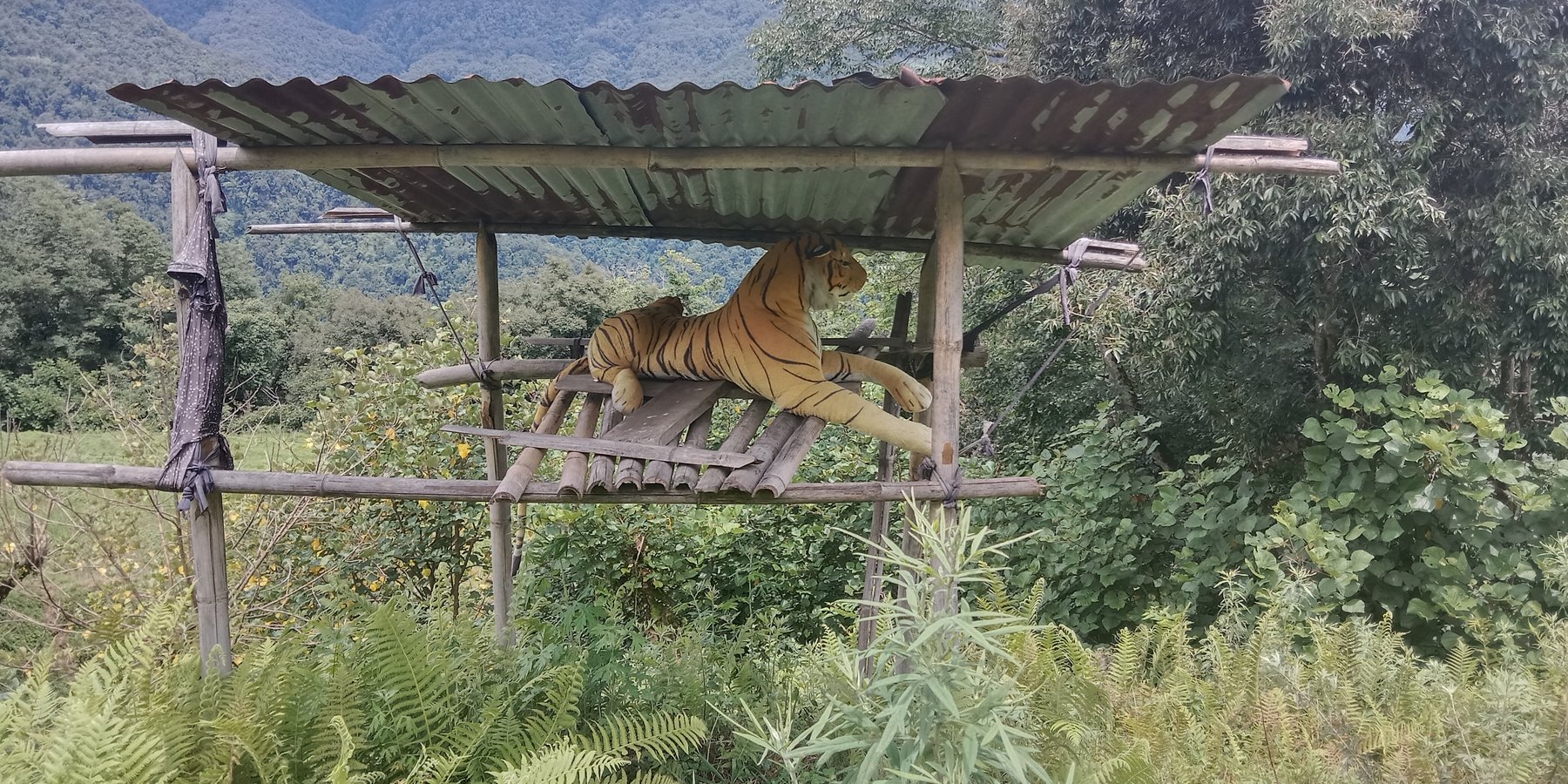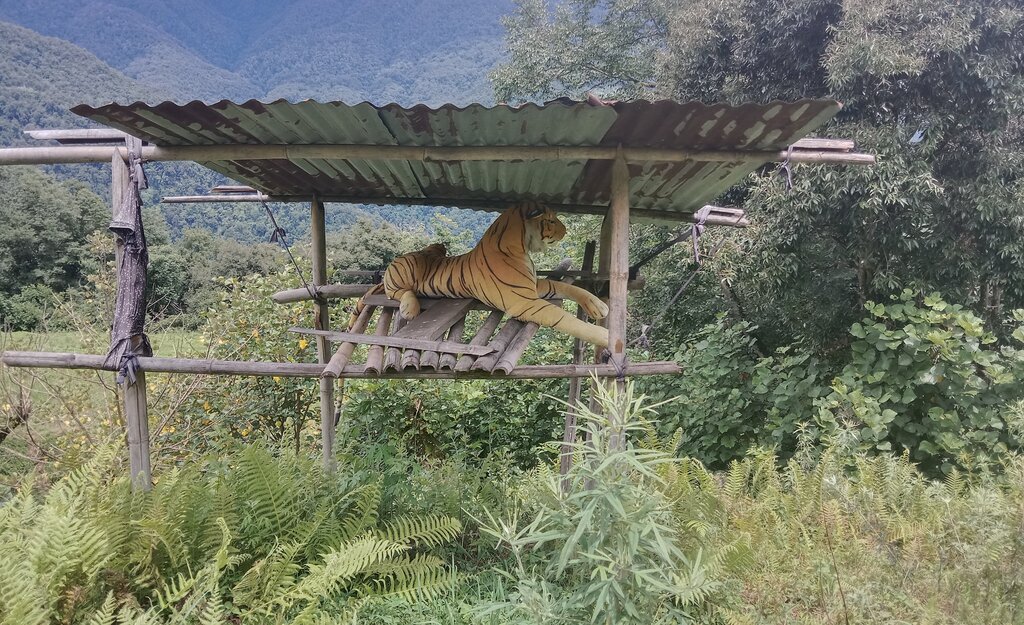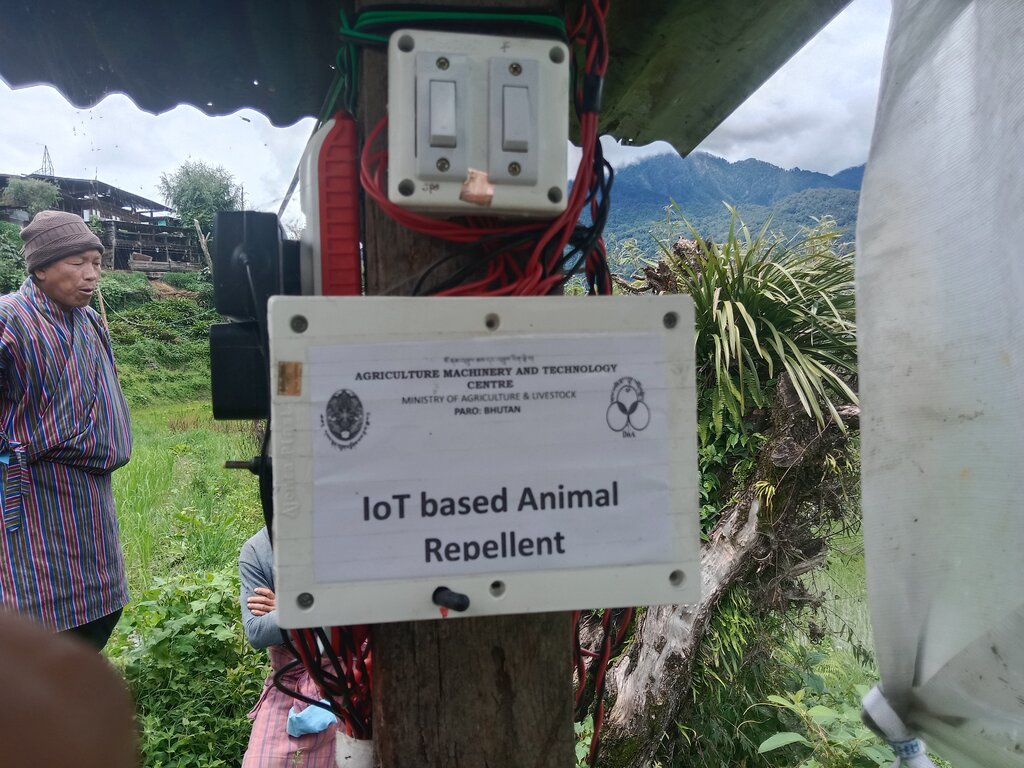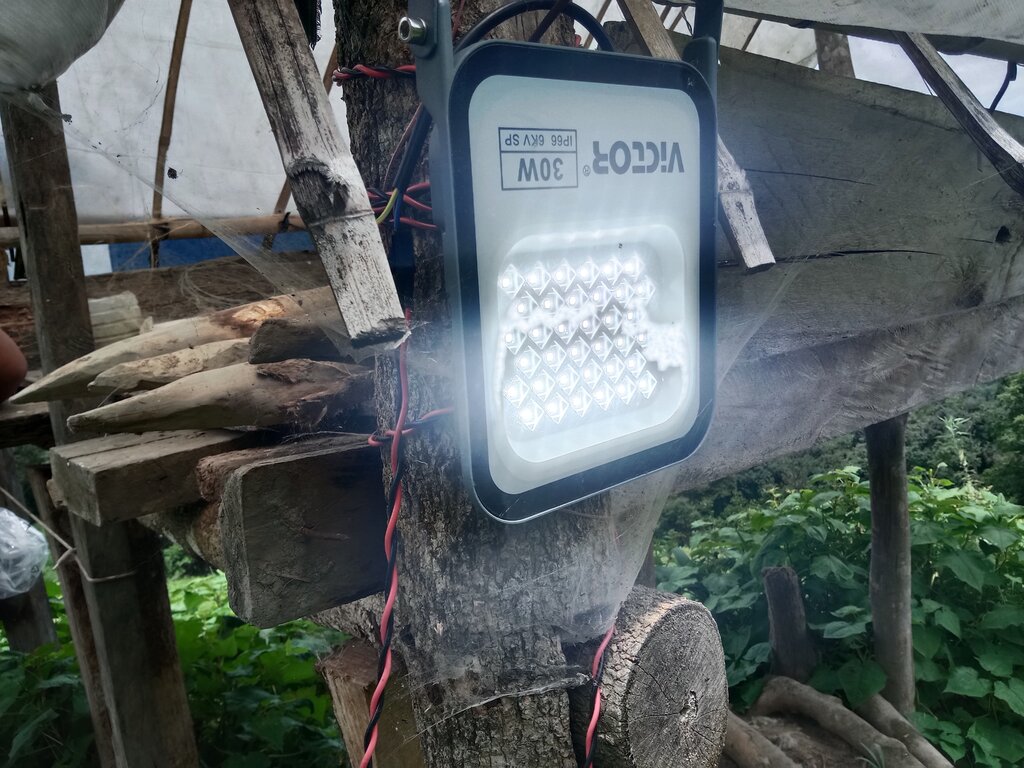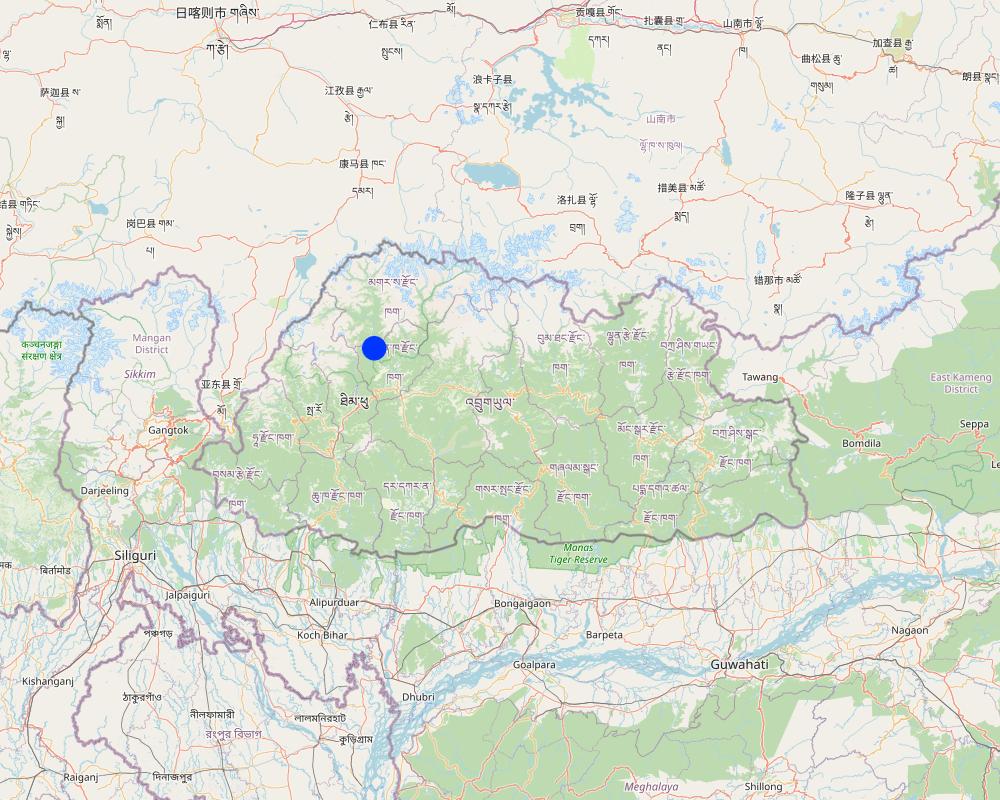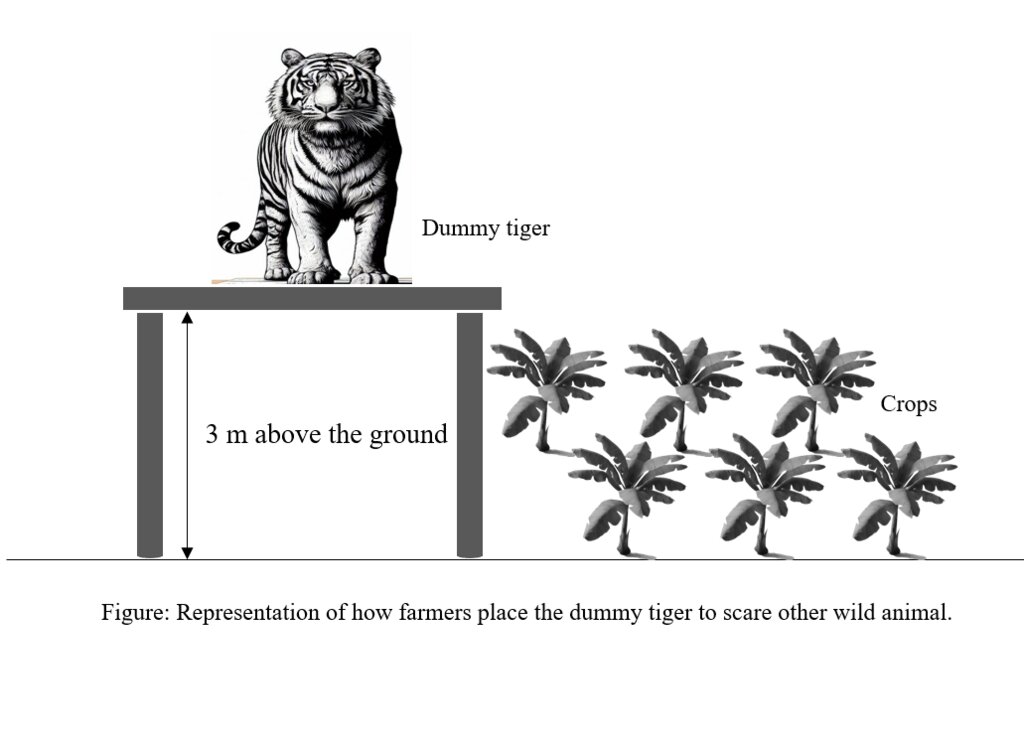Use of Dummy Tigers to Repel Wild Animals [ภูฏาน]
- ผู้สร้างสรรค์:
- การอัพเดท:
- ผู้รวบรวม: Tshering Yangzom
- ผู้เรียบเรียง: chenga Tshering
- ผู้ตรวจสอบ: Rima Mekdaschi Studer, William Critchley, Joana Eichenberger
Tag Zuenma Laglen Thabtey Lothog Sungni (སྟག་རྫུན་མ་ལག་ལེན་འཐབ་སྟེ་ལོ་ཐོག་སྲུང་ནི།)
technologies_6860 - ภูฏาน
ดูส่วนย่อย
ขยายทั้งหมด ย่อทั้งหมด1. ข้อมูลทั่วไป
1.2 รายละเอียดที่ติดต่อได้ของผู้รวบรวมและองค์กรที่เกี่ยวข้องในการประเมินและการจัดเตรียมทำเอกสารของเทคโนโลยี
วิทยากรหลัก
ผู้ใช้ที่ดิน:
Tshering
Drochukha Chiwog (Community), Goenshari Gewog (Block), Punakha Dzongkhag (District)
ภูฏาน
ผู้ใช้ที่ดิน:
Tshering Kinley
Drochukha Chiwog (Community), Goenshari Gewog (Block), Punakha Dzongkhag (District)
ภูฏาน
ผู้ใช้ที่ดิน:
Dorji Kinzang
Drochukha Chiwog (Community), Goenshari Gewog (Block), Punakha Dzongkhag (District)
ภูฏาน
ผู้ใช้ที่ดิน:
Tenzin Namgay
Drochukha Chiwog (Community), Goenshari Gewog (Block), Punakha Dzongkhag (District)
ภูฏาน
ผู้ใช้ที่ดิน:
Kinzang
Drochukha Chiwog (Community), Goenshari Gewog (Block), Punakha Dzongkhag (District)
ภูฏาน
ผู้ใช้ที่ดิน:
Tshering Gyeltshen
Drochukha Chiwog (Community), Goenshari Gewog (Block), Punakha Dzongkhag (District)
ภูฏาน
ผู้ใช้ที่ดิน:
Lhamo Dorji
Drochukha Chiwog (Community), Goenshari Gewog (Block), Punakha Dzongkhag (District)
ภูฏาน
ผู้เชี่ยวชาญ SLM:
Gyeltshen Tshewang
Gewog Agriculture Office, Goenshari Gewog (Block), Punakha Dzongkhag (District)
ภูฏาน
ชื่อของโครงการซึ่งอำนวยความสะดวกในการทำเอกสารหรือการประเมินเทคโนโลยี (ถ้าเกี่ยวข้อง)
Strengthening national-level institutional and professional capacities of country Parties towards enhanced UNCCD monitoring and reporting – GEF 7 EA Umbrella II (GEF 7 UNCCD Enabling Activities_Umbrella II)ชื่อขององค์กรซึ่งอำนวยความสะดวกในการทำเอกสารหรือการประเมินเทคโนโลยี (ถ้าเกี่ยวข้อง)
National Soil Services Center, Department of Agric (National Soil Services Center, Department of Agric) - ภูฏาน1.3 เงื่อนไขการใช้ข้อมูลที่ได้บันทึกผ่านทาง WOCAT
ผู้รวบรวมและวิทยากรหลักยอมรับเงื่อนไขเกี่ยวกับการใช้ข้อมูลที่ถูกบันทึกผ่านทาง WOCAT:
ใช่
1.4 การเปิดเผยเรื่องความยั่งยืนของเทคโนโลยีที่ได้อธิบายไว้
เทคโนโลยีที่ได้อธิบายไว้นี้เป็นปัญหาของความเสื่อมโทรมโทรมของที่ดินหรือไม่ จึงไม่ได้รับการยอมรับว่าเป็นเทคโนโลยีเพื่อการจัดการที่ดินอย่างยั่งยืน:
ไม่ใช่
แสดงความคิดเห็น:
As per the responses, the use of a dummy tiger in guarding crops do not seem to have having direct role in mitigating land degradation. However, it can be claimed as a part of SLM technologies because it protects the crops from wild animals. Standing crops in the field is important to prevent erosion (both soil and water), add nitrogen to the soil (e.g., by leguminous crops), and for nutrient cycling. Also, the use of toy tiger prevents the land user from resorting to fatal methods of crop guarding that necessitates the killing of wildlife.
2. การอธิบายลักษณะของเทคโนโลยี SLM
2.1 การอธิบายแบบสั้น ๆ ของเทคโนโลยี
คำจำกัดความของเทคโนโลยี:
Dummy tigers are used to scare off crop predators. This can be considered a SLM technology because it protects the crops from wild animals which in turn prevents erosion (both soil and water), adds nitrogen to the soil (i.e., by leguminous crops), and helps in nutrient cycling. Furthermore, time is freed up for the farmer to carry out other SLM activities.
2.2 การอธิบายแบบละเอียดของเทคโนโลยี
คำอธิบาย:
In the region of Drochukha, Bhutan, the foremost challenge faced by rural communities is crops damage by wildlife. Land users in this area contend with damage inflicted by a variety of wild animals, including wild boar, barking deer, sambar deer, monkeys, porcupines, bears, and rats. To mitigate crop damage by wildlife, the land users of Drochukha have implemented a unique solution by strategically placing dummy tigers to deter these animals and safeguard their crops.
In 2018, a woman from Drochukha initiated the idea of using dummy tigers to protect crops, and it proved to be highly successful. Following this, other residents also adopted the practice. Farmlands situated near the forest's periphery experience the most significant crop damage by wild animals. By placing dummy tigers near the forest's edge, the land users have not only reduced wildlife attacks in the peripheral regions but also significantly decreased such incidents in the central areas. To protect their crops from wild animals, they procured a dummy tiger at a cost of Nu. 3,380 (about USD 40) from Bajo town in Wangduephodrang Dzongkhag and another dummy tiger costing Nu. 2,000 (about USD 25) from the Indian market in Jaigaon. The land users constructed a raised wooden platform by placing four wooden poles in the ground and adding planks over them to support the dummy tigers, ensuring that they faced the forest.
The implementation of dummy tigers (two) has yielded numerous benefits for 21 households in the region. With the adoption of this innovative approach, Drochukha farmers have been able to increase their crop production and rejuvenate previously unused lands. Dummy tigers effectively safeguard standing crops and prevent wildlife depredation. Maintaining standing crops in the fields is essential to prevent erosion, both of soil and water, while also contributing nitrogen to the soil through the cultivation of leguminous crops and facilitating nutrient cycling. An important aspect of employing dummy tigers is that it prevents land users from resorting to fatal methods of crop protection that may involve the killing of wildlife. Human-wildlife conflicts have thus been reduced. The primary current concern of the land users of Drochukha is the fading colour of the dummy tigers, and they are eager for improved interventions that may involve mobile and sound-producing tigers.
The Agriculture Machinery Centre (AMC) and the Dzongkhag Agriculture Office (DAO) have joined forces to create an IoT-based animal-repellent system. This system, positioned at the field's periphery, comprises three primary components: a speaker, a receptor card, and an amplifier. Once connected to an owner's smartphone, the system allows for the remote playback of various animal sounds. One system, consisting of a single receptor card, can be linked to up to five users. Additionally, two LED flashlights are integrated into the system to deter wild boars at night through powerful pulse flashes. The complete system comes at a cost of Nu. 30,000. Moreover, in their most recent endeavors, AMC and DAO are currently developing a robotic tiger capable of moving its head and limbs, enabling it to patrol the guardhouse and serve as a further deterrent to wildlife. The technology is being piloted as a project to evaluate its effectiveness in the field through trials.
2.3 รูปภาพของเทคโนโลยี
คำอธิบายภาพ:
The IoT-based animal-repellent system is one of the promising technologies that evolved with the need to guard the field in the absence of humans.
2.5 ประเทศภูมิภาค หรือสถานที่ตั้งที่เทคโนโลยีได้นำไปใช้และได้รับการครอบคลุมโดยการประเมินนี้
ประเทศ:
ภูฏาน
ภูมิภาค/รัฐ/จังหวัด:
Drochukha Chiwog, Goenshari Gewog, Punakha Dzongkhag
ระบุการกระจายตัวของเทคโนโลยี:
- ใช้ ณ จุดที่เฉพาะเจาะจงหรือเน้นไปยังบริเวณพื้นที่ขนาดเล็ก
Is/are the technology site(s) located in a permanently protected area?
ใช่
ถ้าใช่ ระบุ:
The area falls under Jigme Dorji National Park (JDNP). The park is one of the oldest protected areas in Bhutan. Endowed with a high number of endangered plants and animals supported by a huge range of vegetation types and climatic regimes, JDNP is undoubtedly the conservation jewel in the Eastern Himalayas. It is also the treasure trove of medicinal plants, natural hot springs, medicinal waters, and jaw-dropping sceneries, unparalleled in the country.
Map
×2.6 วันที่การดำเนินการ
ระบุปีที่ใช้:
2018
2.7 คำแนะนำของเทคโนโลยี
ให้ระบุว่าเทคโนโลยีถูกแนะนำเข้ามาอย่างไร:
- ด้วยการริเริ่มของผู้ใช้ที่ดินเอง
ความคิดเห็น (ประเภทของโครงการ เป็นต้น) :
A lady named Dorji Lhamo of the community, originally from Mongar (Eastern Bhutan) has seen some tiger toys placed at the field peripheries to scare away the wild animals while making her visit to her native village. With much curiosity, she tried doing the same thing in Drochukha (Western Bhutan) where she currently lives. It worked, especially in scaring monkeys away.
3. การจัดประเภทของเทคโนโลยี SLM
3.1 วัตถุประสงค์หลักของเทคโนโลยี
- ปรับปรุงการผลิตให้ดีขึ้น
- อนุรักษ์ระบบนิเวศน์
- สร้างผลกระทบทางด้านเศรษฐกิจที่เป็นประโยชน์
- สร้างผลกระทบทางด้านสังคมที่เป็นประโยชน์
3.2 ประเภทของการใช้ที่ดินในปัจจุบันที่ได้นำเทคโนโลยีไปใช้
Land use mixed within the same land unit:
ใช่
Specify mixed land use (crops/ grazing/ trees):
- วนเกษตร (Agroforestry)

พื้นที่ปลูกพืช
- การปลูกพืชล้มลุกอายุปีเดียว
- การปลูกพืชยืนต้นที่ไม่มีเนื้อไม้
- การปลูกไม้ยืนต้น ไม้พุ่ม
Annual cropping - Specify crops:
- cereals - barley
- cereals - maize
- cereals - rice (wetland)
- cereals - wheat (winter)
Perennial (non-woody) cropping - Specify crops:
- banana/plantain/abaca
- herbs, chili, capsicum
Tree and shrub cropping - Specify crops:
- avocado
- citrus
จำนวนของฤดูเพาะปลูกต่อปี:
- 1
Is intercropping practiced?
ใช่
If yes, specify which crops are intercropped:
Vegetables are intercropped.
Is crop rotation practiced?
ใช่
ถ้าใช่ ระบุ:
Vegetables are rotated.

ป่า/พื้นที่ทำไม้
- ป่ากึ่งธรรมชาติ / พื้นที่ทำไม้
(Semi-)natural forests/ woodlands: Specify management type:
- การตัดไม้ที่มีคัดเลือก (Selective felling)
- การใช้ประโยชน์จากป่า ยกเว้นไม้
Are the trees specified above deciduous or evergreen?
- mixed deciduous/ evergreen
ผลิตภัณฑ์และบริการ:
- ไม้ซุง
- ไม้ที่นำมาทำเป็นเชื้อเพลิง
- ผลิตภัณฑ์อื่น ๆ จากป่า
3.3 Has land use changed due to the implementation of the Technology?
Has land use changed due to the implementation of the Technology?
- No (Continue with question 3.4)
3.4 การใช้น้ำ
การใช้น้ำของที่ดินที่มีการใช้เทคโนโลยีอยู่:
- น้ำฝนร่วมกับการชลประทาน
แสดงความคิดเห็น:
The community has two irrigation sources, Khaow Lum benefiting 6 households, and Jaga Lum benefiting all 21 households.
3.5 กลุ่ม SLM ที่ตรงกับเทคโนโลยีนี้
- Human-wildlife conflict management
3.6 มาตรการ SLM ที่ประกอบกันเป็นเทคโนโลยี

มาตรการอนุรักษ์ด้วยโครงสร้าง
- S11: อื่น ๆ
แสดงความคิดเห็น:
This SLM technology would fall under the structure category as it requires a simple structural wooden stand to place the tiger toys.
3.7 รูปแบบหลักของการเสื่อมโทรมของที่ดินที่ได้รับการแก้ไขโดยเทคโนโลยี

การกัดกร่อนของดินโดยน้ำ
- Wt (Loss of topsoil): การสูญเสียดินชั้นบนหรือการกัดกร่อนที่ผิวดิน

การกัดกร่อนของดินโดยลม
- Et (Loss of topsoil): การสูญเสียดินชั้นบน

การเสื่อมโทรมของดินทางด้านชีวภาพ
- Bc (Reduction of vegetation cover): การลดลงของจำนวนพืชที่ปกคลุมดิน
แสดงความคิดเห็น:
Based on the responses, it appears that the utilization of toy tiger decoys for crop protection may not be directly associated with mitigating land degradation. Nevertheless, it can be considered a component of Sustainable Land Management (SLM) technologies since it serves to safeguard crops from wildlife damage. Preserving standing crops in fields holds significance in preventing erosion, both in terms of soil and water. Furthermore, standing crops contribute to soil enrichment by introducing nitrogen (e.g., through leguminous crops) and facilitate nutrient cycling. Another crucial aspect is that the toy tigers effectively deter wildlife from preying on crops, and they also aid in repelling vertebrate pests from fields.
3.8 การป้องกัน การลดลง หรือการฟื้นฟูความเสื่อมโทรมของที่ดิน
ระบุเป้าหมายของเทคโนโลยีกับความเสื่อมโทรมของที่ดิน:
- ป้องกันความเสื่อมโทรมของที่ดิน
- ลดความเสื่อมโทรมของดิน
แสดงความคิดเห็น:
Based on the responses, it seems that the use of toy tigers may not directly address land degradation. However, it can be categorized as a component of Sustainable Land Management (SLM) technologies because it plays a role in protecting crops from wildlife damage. Maintaining standing crops in fields is essential for erosion prevention, both in terms of soil and water conservation. Additionally, it contributes to soil enrichment by introducing nitrogen, especially through the cultivation of leguminous crops, and supports nutrient cycling. Another significant aspect is that toy tigers effectively serve as a deterrent against wildlife crop depredation and help in repelling vertebrate pests from fields
4. ข้อมูลจำเพาะด้านเทคนิค กิจกรรมการนำไปปฏิบัติใช้ ปัจจัยนำเข้า และค่าใช้จ่าย
4.1 แบบแปลนทางเทคนิคของเทคโนโลยี
ข้อมูลจำเพาะด้านเทคนิค (แบบแปลนทางเทคนิคของเทคโนโลยี):
The tiger toys are placed 3 meters above the ground. To ensure stability, the toys are placed on the planks supported by strong poles.
ผู้เขียน:
Ongpo Lepcha
วันที่:
11/12/2023
4.2 ข้อมูลทั่วไปเกี่ยวกับการคำนวณปัจจัยนำเข้าและค่าใช้จ่าย
ให้ระบุว่าค่าใช้จ่ายและปัจจัยนำเข้าได้รับการคำนวณอย่างไร:
- ต่อหน่วยเทคโนโลยี
อื่นๆ หรือสกุลเงินประจำชาติ (ระบุ):
Nu.
If relevant, indicate exchange rate from USD to local currency (e.g. 1 USD = 79.9 Brazilian Real): 1 USD =:
80.0
ระบุค่าเฉลี่ยของค่าจ้างในการจ้างแรงงานต่อวัน:
800
4.3 กิจกรรมเพื่อการจัดตั้ง
| กิจกรรม | Timing (season) | |
|---|---|---|
| 1. | Procurement of tiger toys. | Before cropping season |
| 2. | Construction of guard houses using any available materials to place the tiger toys. | Before cropping season |
| 3. | Placing the tiger toys. | Cropping season |
แสดงความคิดเห็น:
The need for repainting the faded colours and the lack of movement of the tiger toys are the shortcomings associated with this technology.
4.4 ค่าใช้จ่ายของปัจจัยนำเข้าที่จำเป็นสำหรับการจัดตั้ง
| ปัจจัยนำเข้า | หน่วย | ปริมาณ | ค่าใช้จ่ายต่อหน่วย | ค่าใช้จ่ายทั้งหมดต่อปัจจัยนำเข้า | %ของค่าใช้จ่ายที่ก่อให้เกิดขึ้นโดยผู้ใช้ที่ดิน | |
|---|---|---|---|---|---|---|
| แรงงาน | Labor | man/day | 1.0 | 800.0 | 800.0 | 100.0 |
| อื่น ๆ | Tiger toy | No. | 1.0 | 3380.0 | 3380.0 | 100.0 |
| อื่น ๆ | Tiger toy | No. | 1.0 | 2000.0 | 2000.0 | 100.0 |
| ค่าใช้จ่ายทั้งหมดของการจัดตั้งเทคโนโลยี | 6180.0 | |||||
| Total costs for establishment of the Technology in USD | 77.25 | |||||
แสดงความคิดเห็น:
The current costing is being done based on the local market value of tiger toys. As per the respondents, the tiger toy of the required size cost Nu. 3380 from the local market (Wangdi Phodrang), whereas the same tiger cost Nu. 2000 from the Indian (Jaigoan) market.
4.5 การบำรุงรักษาสภาพหรือกิจกรรมที่เกิดขึ้นเป็นประจำ
แสดงความคิดเห็น:
Since the adoption began in 2018, no maintenance, including the replacement of tiger toys, has been necessary. However, in the upcoming years, maintenance may become necessary due to the fading color of the tiger toys.
4.6 ค่าใช้จ่ายของปัจจัยนำเข้าและกิจกรรมที่เกิดขึ้นเป็นประจำที่ต้องการการบำรุงรักษา (ต่อปี)
If you are unable to break down the costs in the table above, give an estimation of the total costs of maintaining the Technology:
5346.0
แสดงความคิดเห็น:
Buying two new dummy tigers as replacements would cost approximately 66 USD (Nu. 5346) on the higher pricing end and around 50 USD (Nu. 4050) on the lower pricing end.
5. สิ่งแวดล้อมทางธรรมชาติและของมนุษย์
5.1 ภูมิอากาศ
ฝนประจำปี
- < 250 ม.ม.
- 251-500 ม.ม.
- 501-750 ม.ม.
- 751-1,000 ม.ม.
- 1,001-1,500 ม.ม.
- 1,501-2,000 ม.ม.
- 2,001-3,000 ม.ม.
- 3,001-4,000 ม.ม.
- > 4,000 ม.ม.
เขตภูมิอากาศเกษตร
- กึ่งแห้งแล้ง
Dry sub tropical
5.2 สภาพภูมิประเทศ
ค่าเฉลี่ยความลาดชัน:
- ราบเรียบ (0-2%)
- ลาดที่ไม่ชัน (3-5%)
- ปานกลาง (6-10%)
- เป็นลูกคลื่น (11-15%)
- เป็นเนิน (16-30%)
- ชัน (31-60%)
- ชันมาก (>60%)
ธรณีสัณฐาน:
- ที่ราบสูง/ที่ราบ
- สันเขา
- ไหล่เขา
- ไหล่เนินเขา
- ตีนเนิน
- หุบเขา
ระดับความสูง:
- 0-100 เมตร
- 101-500 เมตร
- 501-1,000 เมตร
- 1,001-1,500 เมตร
- 1,501-2,000 เมตร
- 2,001-2,500 เมตร
- 2,501-3,000 เมตร
- 3,001-4,000 เมตร
- > 4,000 เมตร
ให้ระบุถ้าเทคโนโลยีได้ถูกนำไปใช้:
- ไม่เกี่ยวข้อง
5.3 ดิน
ค่าเฉลี่ยความลึกของดิน:
- ตื้นมาก (0-20 ซ.ม.)
- ตื้น (21-50 ซ.ม.)
- ลึกปานกลาง (51-80 ซ.ม.)
- ลึก (81-120 ซ.ม.)
- ลึกมาก (>120 ซ.ม.)
เนื้อดิน (ดินชั้นบน):
- หยาบ/เบา (ดินทราย)
- ปานกลาง (ดินร่วน ทรายแป้ง)
เนื้อดินล่าง (> 20 ซ.ม.ต่ำจากผิวดิน):
- หยาบ/เบา (ดินทราย)
- ปานกลาง (ดินร่วน ทรายแป้ง)
อินทรียวัตถุในดิน:
- สูง (>3%)
(ถ้ามี) ให้แนบคำอธิบายเรื่องดินแบบเต็มหรือระบุข้อมูลที่มีอยู่ เช่น ชนิดของดิน ค่า pH ของดินหรือความเป็นกรดของดิน ความสามารถในการแลกเปลี่ยนประจุบวก ไนโตรเจน ความเค็ม เป็นต้น:
Moisture content-3.10%
Organic matter-7.08 %
Organic carbon-4.12%
pH-6.35
Electrical conductivity-181.33 µs/cm
Nitrogen-0.21
Phosphorus-0.21
Potassium-81.90 mg/100ml
Soil texture-Loamy sand
5.4 ความเป็นประโยชน์และคุณภาพของน้ำ
ระดับน้ำใต้ดิน:
5-50 เมตร
น้ำไหลบ่าที่ผิวดิน:
ดี
คุณภาพน้ำ (ที่ยังไม่ได้บำบัด):
เป็นน้ำเพื่อการดื่มที่ดี
Water quality refers to:
surface water
ความเค็มของน้ำเป็นปัญหาหรือไม่:
ไม่ใช่
กำลังเกิดน้ำท่วมในพื้นที่หรือไม่:
ไม่ใช่
ความคิดเห็นและข้อมูลจำเพาะเพิ่มเติมเรื่องคุณภาพและปริมาณน้ำ:
A landslide in the community was recorded in 1991, losing about one acre of land.
5.5 ความหลากหลายทางชีวภาพ
ความหลากหลายทางชนิดพันธุ์:
- สูง
ความหลากหลายของแหล่งที่อยู่:
- สูง
ความคิดเห็นและข้อมูลจำเพาะเพิ่มเติมของความหลากหลายทางชีวภาพ:
The greater vegetation coverage at the outskirts of the community indicates a higher level of habitat and species biodiversity.
5.6 ลักษณะของผู้ใช้ที่ดินที่นำเทคโนโลยีไปปฏิบัติใช้
อยู่กับที่หรือเร่ร่อน:
- อยู่กับที่
แนวทางการตลาดของระบบการผลิต:
- mixed (subsistence/ commercial)
รายได้ที่มาจากนอกฟาร์ม:
- 10-50% ของรายได้ทั้งหมด
ระดับของความมั่งคั่งโดยเปรียบเทียบ:
- พอมีพอกิน
เป็นรายบุคคล/ครัวเรือน:
- เป็นรายบุคคล/ครัวเรือน
ระดับของการใช้เครื่องจักรกล:
- งานที่ใช้แรงกาย
- การใช้เครื่องจักรหรือเครื่องยนต์
เพศ:
- หญิง
- ชาย
อายุของผู้ใช้ที่ดิน:
- ผู้เยาว์
- วัยกลางคน
ระบุลักษณะอื่นๆที่เกี่ยวข้องของผู้ใช้ที่ดิน:
The Drochukha community came into existence after their ancestors migrated to the current site from Gasa Dzongkhag some 50 years ago. Only 2 of 21 households are native.
5.7 Average area of land used by land users applying the Technology
- < 0.5 เฮกตาร์
- 0.5-1 เฮกตาร์
- 1-2 เฮกตาร์
- 2-5 เฮกตาร์
- 5-15 เฮกตาร์
- 15-50 เฮกตาร์
- 50-100 เฮกตาร์
- 100-500 เฮกตาร์
- 500-1,000 เฮกตาร์
- 1,000-10,000 เฮกตาร์
- >10,000 เฮกตาร์
พิจารณาว่าเป็นขนาดเล็ก กลาง หรือขนาดใหญ่ (ซึ่งอ้างอิงถึงบริบทระดับท้องถิ่น):
- ขนาดกลาง
แสดงความคิดเห็น:
The land holdings of the household in the community range from 1 - 5 acres, a mix of small-scale and large-scale as per the local context. The average land holding at the national level is 3 acres (1.2 ha)
In the local context:
3 acres (1.2 ha) = medium scale
> 3 acres = large-scale
<3 acres = small-scale
5.8 กรรมสิทธิ์ในที่ดิน สิทธิในการใช้ที่ดินและสิทธิในการใช้น้ำ
- Family land
สิทธิในการใช้ที่ดิน:
- รายบุคคล
สิทธิในการใช้น้ำ:
- เกี่ยวกับชุมชน (ถูกจัดระเบียบ)
- รายบุคคล
Are land use rights based on a traditional legal system?
ใช่
ระบุ:
The land use rights in Bhutan is based on a traditional legal system guided by formal land act and land rules and regulations.
5.9 การเข้าถึงบริการและโครงสร้างพื้นฐาน
สุขภาพ:
- จน
- ปานกลาง
- ดี
การศึกษา:
- จน
- ปานกลาง
- ดี
ความช่วยเหลือทางด้านเทคนิค:
- จน
- ปานกลาง
- ดี
การจ้างงาน (เช่น ภายนอกฟาร์ม):
- จน
- ปานกลาง
- ดี
ตลาด:
- จน
- ปานกลาง
- ดี
พลังงาน:
- จน
- ปานกลาง
- ดี
ถนนและการขนส่ง:
- จน
- ปานกลาง
- ดี
น้ำดื่มและการสุขาภิบาล:
- จน
- ปานกลาง
- ดี
บริการด้านการเงิน:
- จน
- ปานกลาง
- ดี
6. ผลกระทบและสรุปคำบอกกล่าว
6.1 ผลกระทบในพื้นที่ดำเนินการ (On-site) จากการใช้เทคโนโลยี
ผลกระทบทางด้านเศรษฐกิจและสังคม
การผลิต
การผลิตพืชผล
จำนวนก่อน SLM:
125kg
หลังจาก SLM:
250kg
แสดงความคิดเห็น/ระบุ:
Previously, farmers could only harvest approximately 125 kg of potatoes when planting 250 kg of seeds. Now, they can harvest nearly 1500 kg of potatoes from the same amount of seeds.
รายได้และค่าใช้จ่าย
ค่าใช่จ่ายของปัจจัยการผลิตทางการเกษตร
แสดงความคิดเห็น/ระบุ:
Daytime crop guarding against monkeys is no longer necessary, allowing land users to allocate their time to other productive activities.
รายได้จากฟาร์ม
แสดงความคิดเห็น/ระบุ:
With no need for daytime crop guarding, land users can engage in off-farm activities, earning up to Nu. 800 per day. This has proven to be advantageous in increasing their overall farm income.
ความหลากหลายของแหล่งผลิตรายได้
แสดงความคิดเห็น/ระบุ:
Off-farm earning has become possible. Production and marketing of other seasonal crops and high-value crops are possible.
ภาระงาน
แสดงความคิดเห็น/ระบุ:
The continuous daytime guarding is not required anymore.
ผลกระทบด้านสังคมวัฒนธรรมอื่น ๆ
ความมั่นคงด้านอาหาร / พึ่งตนเองได้
แสดงความคิดเห็น/ระบุ:
The land users can produce enough for self-consumption and commercialization.
โอกาสทางวัฒนธรรม
แสดงความคิดเห็น/ระบุ:
The use of lethal methods for crop protection is no longer necessary, thus preventing the killing of wild animals
ผลกระทบด้านนิเวศวิทยา
ความหลากหลายทางชีวภาพของพืชและสัตว์
การจัดการศัตรูพืชและโรคพืช
แสดงความคิดเห็น/ระบุ:
The control of vertebrate pests, especially monkeys, has been very successful.
6.2 ผลกระทบนอกพื้นที่ดำเนินการ (Off-site) จากการใช้เทคโนโลยี
Protection of farms further from the land users' farms
แสดงความคิดเห็น/ระบุ:
Toy tigers protect farms further from the land users' farms also. There is no intrusion of wild animals into the villages.
6.3 การเผชิญและความตอบสนองของเทคโนโลยีต่อการเปลี่ยนแปลงสภาพภูมิอากาศที่ค่อยเป็นค่อยไป และสภาพรุนแรงของภูมิอากาศ / ภัยพิบัติ (ที่รับรู้ได้โดยผู้ใช้ที่ดิน)
การเปลี่ยนแปลงสภาพภูมิอากาศที่ค่อยเป็นค่อยไป
การเปลี่ยนแปลงสภาพภูมิอากาศที่ค่อยเป็นค่อยไป
| ฤดู | increase or decrease | เทคโนโลยีมีวิธีการรับมืออย่างไร | |
|---|---|---|---|
| อุณหภูมิประจำปี | เพิ่มขึ้น | ดีมาก | |
| ฝนประจำปี | เพิ่มขึ้น | ดีมาก |
สภาพรุนแรงของภูมิอากาศ (ภัยพิบัติ)
ภัยพิบัติทางอุตุนิยมวิทยา
| เทคโนโลยีมีวิธีการรับมืออย่างไร | |
|---|---|
| พายุฝนประจำท้องถิ่น | ดีมาก |
| พายุฝนฟ้าคะนองประจำท้องถิ่น | ดีมาก |
| พายุลูกเห็บประจำท้องถิ่น | ดีมาก |
| พายุลมประจำท้องถิ่น | ดีมาก |
ภัยพิบัติจากสภาพภูมิอากาศ
| เทคโนโลยีมีวิธีการรับมืออย่างไร | |
|---|---|
| สภาพอากาศฤดูหนาวที่รุนแรง | ดีมาก |
ภัยพิบัติทางชีวภาพ
| เทคโนโลยีมีวิธีการรับมืออย่างไร | |
|---|---|
| โรคระบาด | ดีมาก |
| การบุกรุกของแมลง / หนอน | ดีมาก |
6.4 การวิเคราะห์ค่าใช้จ่ายและผลประโยชน์ที่ได้รับ
ผลประโยชน์ที่ได้รับเปรียบเทียบกับค่าใช้จ่ายในการจัดตั้งเป็นอย่างไร (จากมุมมองของผู้ใช้ที่ดิน)
ผลตอบแทนระยะสั้น:
ด้านบวกอย่างมาก
ผลตอบแทนระยะยาว:
ด้านบวกอย่างมาก
ผลประโยชน์ที่ได้รับเปรียบเทียบกับค่าใช้จ่ายในการบำรุงรักษาหรือต้นทุนที่เกิดขึ้นซ้ำอีก เป็นอย่างไร (จากมุมมองของผู้ใช้ที่ดิน)
ผลตอบแทนระยะสั้น:
ด้านบวกอย่างมาก
ผลตอบแทนระยะยาว:
ด้านบวกอย่างมาก
แสดงความคิดเห็น:
The technology is cost effective and every individual can afford it easily.
6.5 การปรับตัวของเทคโนโลยี
- 11-50%
ถ้ามีข้อมูลให้บอกปริมาณด้วย (จำนวนของครัวเรือนหรือครอบคลุมพื้นที่):
Out of the 21 households, 10 have embraced the technology. The reason for this is primarily that the remaining 11 households have their lands situated in the central part of the community and do not share boundaries with the forests.
Of all those who have adopted the Technology, how many did so spontaneously, i.e. without receiving any material incentives/ payments?
- 91-100%
แสดงความคิดเห็น:
The expenditures were borne by the farmers. No external funding was involved in buying tiger toys.
6.6 การปรับตัว
เทคโนโลยีได้รับการปรับเปลี่ยนเมื่อเร็วๆนี้ เพื่อให้ปรับตัวเข้ากับสภาพที่กำลังเปลี่ยนแปลงหรือไม่:
ใช่
อื่น ๆ (ระบุ):
Modern technology integration
ให้ระบุการปรับตัวของเทคโนโลยี (การออกแบบ วัสดุหรือชนิดพันธุ์ เป็นต้น):
The Agriculture Machinery Centre (AMC) and the Dzongkhag Agriculture Office (DAO) have joined forces to create an IoT-based animal-repellent system. This system, positioned at the field's periphery, comprises three primary components: a speaker, a receptor card, and an amplifier. Once connected to a owner's smartphone, the system allows for the remote playback of various animal sounds. One system, consisting of a single receptor card, can be linked to up to five users. Additionally, two LED flashlights are integrated into the system to deter wild boars at night through powerful pulse flashes. The complete system comes at a cost of Nu. 30,000.
Moreover, in their most recent endeavors, AMC and DAO are currently developing a robotic tiger capable of moving its head and limbs, enabling it to patrol the guardhouse and serve as a further deterrent to wildlife. The technology is being piloted as a project to evaluate its effectiveness in the field through trials.
6.7 จุดแข็ง / ข้อได้เปรียบ / โอกาสของเทคโนโลยี
| จุดแข็ง / ข้อได้เปรียบ / โอกาสในทัศนคติของผู้ใช้ที่ดิน |
|---|
| The crop production is enhanced. |
| Lethal methods for crop protection have been avoided. |
| Overall farm income is increased after the adoption of technology. |
| จุดแข็ง / ข้อได้เปรียบ / โอกาสในทัศนคติของผู้รวบรวมหรือวิทยากรหลัก |
|---|
| No major threats to the external environment and user friendly technology. |
| Tiger toy protects the crops from wild animals. Standing crops in the field is important to prevent erosion (both soil and water), add nitrogen to the soil (e.g., by leguminous crops), and for nutrient cycling. The other important aspect is toy tiger prevents wildlife depredation. |
6.8 จุดอ่อน / ข้อเสียเปรียบ / ความเสี่ยงของเทคโนโลยีและวิธีการแก้ไข
| จุดอ่อน / ข้อเสียเปรียบ / ความเสี่ยงในทัศนคติของผู้ใช้ที่ดิน | มีวิธีการแก้ไขได้อย่างไร |
|---|---|
| The colour fading of tiger toys could be a problem in the future. | Repaint toy tigers. |
| Financial burden on the land users. | Implement a cost-sharing mechanism. |
| จุดอ่อน / ข้อเสียเปรียบ / ความเสี่ยงในทัศนคติของผู้รวบรวมหรือวิทยากรหลัก | มีวิธีการแก้ไขได้อย่างไร |
|---|---|
| The wild animals especially the monkeys might get used to tiger toys. | A robotic tiger producing sounds in certain intervals would be the next best innovation, which is already under process. |
7. การอ้างอิงและการเชื่อมต่อ
7.1 วิธีการและแหล่งข้อมูล
- ไปเยี่ยมชมภาคสนาม การสำรวจพื้นที่ภาคสนาม
7
- การสัมภาษณ์กับผู้ใช้ที่ดิน
7
- การสัมภาษณ์ผู้เชี่ยวชาญด้าน SLM หรือผู้ชำนาญ
1
วันที่เก็บรวบรวมข้อมูล(ภาคสนาม) :
18/07/2023
7.3 Links to relevant online information
ชื่อเรื่องหรือคำอธิบาย:
Introduction – Jigme Dorji National Park
URL:
https://www.dofps.gov.bt/introduction-jigme-dorji-national-park/
ลิงก์และโมดูล
ขยายทั้งหมด ย่อทั้งหมดลิงก์
ไม่มีลิงก์
โมดูล
ไม่มีโมดูล


